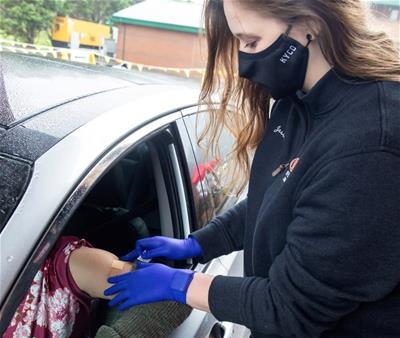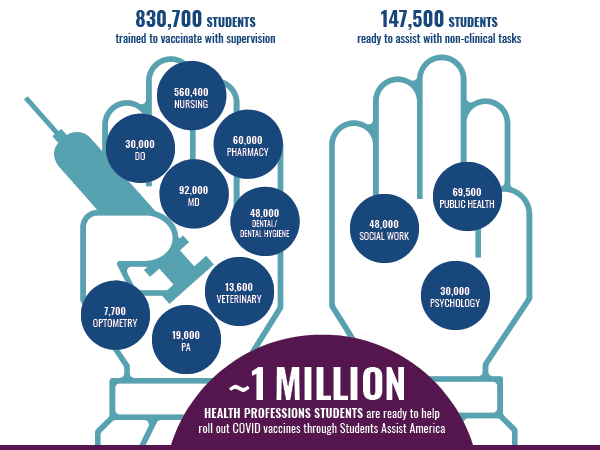Students Assist America: An Interprofessional Effort in a Time of Crisis
Published April 29, 2021
2021
Just over one year ago, as Robert A. Cain, DO, AACOM President and CEO, was watching the COVID-19 pandemic unfold, he realized the serious implications not only for public health, but also for the continued clinical training of osteopathic medical students. Both areas were of grave concern, and the question at the time was, “What can we do about this?”

Students Assist America (SAA) was born out of a desire to support the country in a time of crisis, and a need to fill gaps in clinical rotations for DO students as they were being turned away from traditional settings due to lack of personal protective equipment, fear and general chaos. It soon became clear that these challenges were not isolated to osteopathic medical education, but shared across health professions. The SAA net needed to be cast much wider to truly change the trajectory of the healthcare system and ensure it didn’t crumble under the weight of the virus.
Photo: A third-year optometry student at Kentucky College of Optometry at the University of Pikeville gives a COVID-19 vaccination in April 2021.
Under Dr. Cain’s leadership and vision, SAA rapidly grew into a true interprofessional effort of six, then eight, then 10 and ultimately 12 associations that worked together to determine how students could meaningfully contribute to the pandemic’s public health response. “Working in high functioning teams has been proven to increase the well-being of clinicians and improve patient outcomes,” said Lucinda L. Maine, PhD, RPh, Executive Vice President and CEO, American Association of Colleges of Pharmacy and collaborator on Students Assist America. “This translates to team-based, interprofessional efforts outside of the clinical setting as well. As we continue to navigate the challenges of this global pandemic, SAA has played an important ‘connector’ role over the last year in our work together.”
In addition to medicine (DO and MD) and pharmacy, SAA includes nursing, dentistry and dental hygiene, veterinary medicine, PA, optometry, psychology, social work, public health and allied health professions. The goal of SAA is to look for opportunities for students to safely offer direct clinical support as well as public and mental health expertise. After months of discussions with federal and state leaders and no clear direction at either level of government, the SAA groups tracked the growing promise of viable vaccine candidates and in the fall of 2020 found the golden opportunity—supplementing the vaccination workforce.
 SAA has access to more than 830,000 students who are already trained to give intramuscular injections, or who can easily translate their method of injection to the deltoid muscle of the arm. The academic institutions represented
by the 12 associations in SAA can also reach almost 150,000 additional students who can assist with the other aspects of a mass vaccination effort that are non-clinical, but essential to an efficient rollout. SAA turned its full attention to working
with Medical Reserve Corps chapters, Governors’ offices, the National Vaccine Advisory Committee and other entities to highlight the injection training that health professions students receive over the course of their education. Through
outreach to the Biden-Harris COVID-19 Taskforce, the U.S. Department of Health and Human Services and
Members of Congress, in February 2021, the White House announced that it would issue new guidance on who was eligible to administer COVID-19 vaccines. Through an amendment to the 7th Declaration to the Public Readiness and Emergency Response (PREP) Act, supervised medical and other qualified students were now eligible to vaccinate the public against
COVID-19 across all 50 states and U.S. Territories.
SAA has access to more than 830,000 students who are already trained to give intramuscular injections, or who can easily translate their method of injection to the deltoid muscle of the arm. The academic institutions represented
by the 12 associations in SAA can also reach almost 150,000 additional students who can assist with the other aspects of a mass vaccination effort that are non-clinical, but essential to an efficient rollout. SAA turned its full attention to working
with Medical Reserve Corps chapters, Governors’ offices, the National Vaccine Advisory Committee and other entities to highlight the injection training that health professions students receive over the course of their education. Through
outreach to the Biden-Harris COVID-19 Taskforce, the U.S. Department of Health and Human Services and
Members of Congress, in February 2021, the White House announced that it would issue new guidance on who was eligible to administer COVID-19 vaccines. Through an amendment to the 7th Declaration to the Public Readiness and Emergency Response (PREP) Act, supervised medical and other qualified students were now eligible to vaccinate the public against
COVID-19 across all 50 states and U.S. Territories.
This federal action marked the first victory in the SAA quest to raise awareness of the potential for health professions students to help the existing healthcare workforce, and the interprofessional group continues to advocate on Capitol Hill to make this change permanent through federal legislation. Now, with more doses available and a smoother vaccine rollout, the emerging focus reaches beyond the need for shots in arms. SAA is currently examining the threat to well-being and mental health that the pandemic has created for so many Americans, including health professions students, and will be developing resources and other communications to help member institutions tackle this reality on and off their campuses.
For more information, national and local media coverage of SAA, and examples of how colleges of osteopathic medicine are participating in the mass vaccination efforts, please visit aacom.org/mobilize.